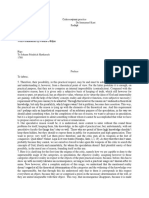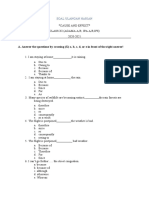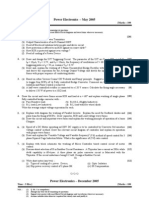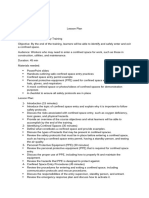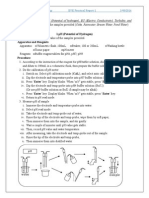Sri Lanka
Sri Lanka
Uploaded by
Aslim MohamedCopyright:
Available Formats
Sri Lanka
Sri Lanka
Uploaded by
Aslim MohamedCopyright
Available Formats
Share this document
Did you find this document useful?
Is this content inappropriate?
Copyright:
Available Formats
Sri Lanka
Sri Lanka
Uploaded by
Aslim MohamedCopyright:
Available Formats
Sri Lanka
General Country
Kabul
Jammu
and
Profile1
Islamabad Kashmir
Afghanistan
Pakistan
New Delhi Nepal Bhutan
Kathmandu Thimphu
Bangladesh
Dhaka
India
Maldives
Sri Lanka is an island located in the Indian Ocean
Colombo
Sri Lanka southwest of the Bay of Bengal.
Male
Maldives
Population: 21,803,000 (Annual Report Central
Bank, 2019); the sex ratio is 46M:54F (estimates
based on Household Income and Expenditure
Survey (HIES), 2016).
This map is stylized and not to scale. The information shown on this map does
not imply official recognition or endorsement of and physical, political boundaries
or feature names by the United Nations or other collaborative organizations. UN
OCHA and affiliated organizations are not liable for damages of any kind related
to the use of this data.
Child population under 18 years: 6,214,692
(estimates based on HIES, 2016).
Poverty headcount ratio at national poverty lines
(% of population): 4 per cent (HIES, 2016).
About a quarter of the population lives just above
the official poverty line, and is extremely vulnera-
ble to economic shocks.
Literacy rate: 93 per cent (Labour Force Survey,
2018).
Life expectancy at birth: 75.5 years (Annual
Report, Central Bank, 2019).
© UNICEF/UN0220415/2012
Income level: Upper Middle-Income Country
(UMIC); per capita income USD 3,741 (Annual
Report, Central Bank, 2019).
[1] Sources of data include: Department of Census and Statistics
Sri Lanka, Central Bank Sri Lanka and World Bank.
Sri Lanka Key Indicators on Children
Indicator Value Year Source
7 per 1,000 Demographic and Health
Neonatal mortality 2016 Survey (DHS)
live births
Stunting in under-five children 17% 2016 DHS
Number of children (0-5 years)
14,500 2016 Department of Probation and Child Care
living in residential care
Early Childhood Education
(participation rate of four-year-olds
in organized learning one year 50% 2017 World Bank, Sri Lanka Education Sector
before the official primary school Assessment, 2017
age entrance)
Secondary education net 2016 Estimates based on HIES
86%
enrolment (15-16 years)
Biggest challenges facing children and UNICEF targets for 2018-2022
• Malnutrition remains a major challenge, indicating the acute need for Key priorities in the new Sri Lanka
quality and multi-sectoral services. Rates of acute malnutrition (wasting) Country Programme 2018–2022
are exceptionally high, at 15 per cent (DHS, 2016).
• Reduce the percentage of stunted
• Poor quality at all levels of education, indicating that the education under-five children to 13 per cent.
system is failing to produce skills that are in high demand in a competitive
economy. There are large disparities in learning achievement by province, • Increase net enrolment rates in secondary
gender, income and location. Only around 50 per cent of children can education to 90 per cent.
access pre-school (World Bank, Sri Lanka Education Sector Assessment,
2017).
• Increase the participation rate in organized
learning one year before the official primary
• Varying poverty levels across the country are a major problem. More school age entrance to 80 per cent.
work needs to be done to ensure that children are not denied opportunities
simply because of the family they are born into or where they live.
• Increase the number of children covered
by social protection systems by 5 per cent.
• Corporal punishment is widespread in Sri Lanka. Encouraging steps
have been taken, including the drafting of a Cabinet Policy Paper to ban
corporal punishment, however the Paper is has been pending submission • Reduce the percentage of girls and boys
to Cabinet for a considerable time. There is still no explicit legal ban on the (aged 1-14) who have experienced violent
practice. Existing circulars are poorly enforced and interventions poorly disciplinary practices (target to be
financed. determined).
• Implement the National Action Plan on
• Sri Lanka continues to grapple with ethnic tensions and
Education for Peace and Reconciliation.
misunderstandings. This continues to have a direct effect on national
development. Tensions between social and ethnic groups often begin in
childhood. • Invest in communities by prioritizing the
resilience and adaptability of education,
health and protection services in
• Sri Lanka is ranked the sixth most vulnerable country in the world with communities across Sri Lanka.
respect to the effects of climate change. Children suffer the most from
the direct physical impact of extreme weather.
© UNICEF/UN0220415/2012
Type of UNICEF programme, presence
and partnerships and salient issues
• The Country Programme Document 2018–2022 has a budget of USD 57.24 Country
million (USD 4.74 million regular resources and USD 52.5 million other Management Team
resources).
• Sri Lanka will employ a mix of upstream and downstream strategies i.e. • Tim Sutton, Representative
system strengthening, strengthening generation of disaggregated data and
integrated service delivery at subnational level. • Emma Brigham, Deputy
Representative
• Corporate alliances with major businesses will be pursued with the aim of
advancing child-centred partnerships and policies and to create mutually • Ruthie Pelpola, Operations
beneficial relationships to maximize resources for children. Manager
• Sri Lanka is a pathfinder country for the Global Partnership to End Violence • Jeremy Sprigge, Communication
against Children (GP-EVAC) and is part of the Scale Up Nutrition (SUN) Specialist
movement.
• Hanaa Singer, United Nations
• UNICEF Sri Lanka has established strategic partnerships with the EU and Resident Coordinator
World Bank on Public Finance for Children; the Korea International Coopera-
tion Agency (KOICA) on quality education services; and Australia’s Depart-
ment of Foreign Affairs and Trade (DFAT) on Child Centred Disaster Risk
Reduction and Gender Based Violence.
You might also like
- Aleksandar Uskokov - The Philosophy of The Brahma-Sūtra - An Introduction-Bloomsbury Academic (2022)Document241 pagesAleksandar Uskokov - The Philosophy of The Brahma-Sūtra - An Introduction-Bloomsbury Academic (2022)G G HegdeNo ratings yet
- Load ChartDocument4 pagesLoad ChartVishnu Menon100% (6)
- SAP SD Certified Fresher CVDocument3 pagesSAP SD Certified Fresher CVRouble Mj67% (3)
- Cameroon Finscope 2017Document44 pagesCameroon Finscope 2017Rolande Annabelle100% (1)
- Grief CounselingDocument24 pagesGrief CounselingDocStevens100% (8)
- 4 - Hydro Jetting and Sludge RemovalDocument18 pages4 - Hydro Jetting and Sludge RemovalPerwez21100% (2)
- MaldivesDocument4 pagesMaldivesOfficial GmailNo ratings yet
- NepalDocument3 pagesNepalGaming's WarthNo ratings yet
- AfghanistanDocument5 pagesAfghanistanmohammadbasirnooriNo ratings yet
- Sustainable Development Goal (SDG) 4Document4 pagesSustainable Development Goal (SDG) 4Samuel EkpoNo ratings yet
- Chapter 6 - Integrated Universal Child Grant in Bihar-IndiaDocument17 pagesChapter 6 - Integrated Universal Child Grant in Bihar-Indialychandy1986No ratings yet
- Health workforce snapshot QATARDocument2 pagesHealth workforce snapshot QATARzassafNo ratings yet
- Development of Poverty Index For DistricDocument6 pagesDevelopment of Poverty Index For DistricSiti Nur Aisya Bt GhazaliNo ratings yet
- VN-Team CatfishDocument15 pagesVN-Team CatfishRachel AlegadoNo ratings yet
- Health workforce s Health workforce s workforce snapshot napshot napshot SUDANDocument2 pagesHealth workforce s Health workforce s workforce snapshot napshot napshot SUDANzassafNo ratings yet
- MBA B Group 4 GhanaDocument28 pagesMBA B Group 4 GhanaAchintya RanjanNo ratings yet
- Global Poveq NgaDocument2 pagesGlobal Poveq NgaabrahamomachicNo ratings yet
- Philippines - YEM - Final Narrative ReportDocument36 pagesPhilippines - YEM - Final Narrative ReportBhergie EstabilloNo ratings yet
- BangladeshDocument4 pagesBangladeshprapti2977No ratings yet
- Module 4 - Is Extreme Poverty Declining - Findings From Agricultural Households in IndiaDocument3 pagesModule 4 - Is Extreme Poverty Declining - Findings From Agricultural Households in IndiaNayana SharmaNo ratings yet
- Eco Chap-1 Part-2Document12 pagesEco Chap-1 Part-2Aryan GoyalNo ratings yet
- Human Development IndexDocument16 pagesHuman Development IndexOwais NazirNo ratings yet
- Human and Economic Assessment of Impact Heat Report Saint LuciaDocument31 pagesHuman and Economic Assessment of Impact Heat Report Saint LuciaLisse EdwardNo ratings yet
- BRIEF - Poverty & Equity Brief - INDONESIADocument2 pagesBRIEF - Poverty & Equity Brief - INDONESIABella NovitaNo ratings yet
- Taguig Reportcard2019Document2 pagesTaguig Reportcard2019John Philip TiongcoNo ratings yet
- Global PovertyDocument2 pagesGlobal PovertyMuhammad IjazNo ratings yet
- Cambodia Country Report - Social Security - April 2017Document14 pagesCambodia Country Report - Social Security - April 2017arie ArizandiNo ratings yet
- MEA Salary Survey ReportDocument12 pagesMEA Salary Survey Reportfabio9187No ratings yet
- UNCDF BTCA Philippines Diagnoctic 20151014Document72 pagesUNCDF BTCA Philippines Diagnoctic 20151014SaurabhRoy100% (1)
- Profile MalaysiaDocument2 pagesProfile MalaysiaRichard T. PetersonNo ratings yet
- Global POVEQ IDNDocument2 pagesGlobal POVEQ IDNhendyNo ratings yet
- Pakistan: Unstacking Global PovertyDocument2 pagesPakistan: Unstacking Global PovertyStylish babyNo ratings yet
- Country ProfileDocument4 pagesCountry Profileeng.dalal955No ratings yet
- State Level Performance of MGNREGA in India A Comparative StudyDocument5 pagesState Level Performance of MGNREGA in India A Comparative StudyVENKY KRISHNANo ratings yet
- 10srilankadrmstatusreportDocument32 pages10srilankadrmstatusreportEOC DMCNo ratings yet
- Policy Brief: PolicymakingDocument4 pagesPolicy Brief: PolicymakingArif Khan NabilNo ratings yet
- Economy PYQ Research shyamDocument11 pagesEconomy PYQ Research shyamIsha SharmaNo ratings yet
- Wcms 853322Document3 pagesWcms 853322Tirsit WoldemariamNo ratings yet
- Economic Cost of Youth Suicide v3Document12 pagesEconomic Cost of Youth Suicide v3laifchan495No ratings yet
- Profile ThailandDocument2 pagesProfile Thailanddarling nanaNo ratings yet
- MDG Progress Report 2005Document101 pagesMDG Progress Report 2005wevev39267No ratings yet
- AugustDocument16 pagesAugustRudrasing ThapaNo ratings yet
- Sim CBM 122 Lesson 2Document7 pagesSim CBM 122 Lesson 2Andrew Sy ScottNo ratings yet
- TVET Brief Issue No. 1 - World Bank Study On Inclusive Development in MindanaoDocument6 pagesTVET Brief Issue No. 1 - World Bank Study On Inclusive Development in MindanaoAsnema BatunggaraNo ratings yet
- Tanzania MFPDocument2 pagesTanzania MFPOswin alexNo ratings yet
- Youth Issues - Sri LankaDocument9 pagesYouth Issues - Sri LankaIroshan SheharaNo ratings yet
- Kenya: Migration ProfileDocument18 pagesKenya: Migration Profilebrianarunga933No ratings yet
- Ending Poverty, Investing in Opportunity: Annual Report 2019Document95 pagesEnding Poverty, Investing in Opportunity: Annual Report 2019Joe BahNo ratings yet
- Un DPDocument31 pagesUn DPfarahadv519No ratings yet
- Mirae Asset Vietnam-Tail of The Dragon Infographic PDFDocument1 pageMirae Asset Vietnam-Tail of The Dragon Infographic PDFHetanshNo ratings yet
- Economic Review English 17-18Document239 pagesEconomic Review English 17-18Shashank SinghNo ratings yet
- Canada Pension Plan: Annual ReportDocument69 pagesCanada Pension Plan: Annual ReportDorothy LamNo ratings yet
- Poverty Stuty Asia - Comparison of CountriesDocument16 pagesPoverty Stuty Asia - Comparison of Countriesjudith patnaanNo ratings yet
- 3.17 Country Evaluation Brief - SomaliaDocument36 pages3.17 Country Evaluation Brief - SomaliaWaafi LiveNo ratings yet
- Rural Youth Employment and Agri Food Systems in Kenya: A Rapid Context AnalysisDocument18 pagesRural Youth Employment and Agri Food Systems in Kenya: A Rapid Context Analysish3493061No ratings yet
- HCI 2pager NZLDocument2 pagesHCI 2pager NZLMatthew MatiyengaNo ratings yet
- Sri LankaDocument21 pagesSri LankaKiara ManiarNo ratings yet
- MySkills PresentationDocument26 pagesMySkills PresentationDinesan PatmaNo ratings yet
- Grade 10 Development Notes PDFDocument7 pagesGrade 10 Development Notes PDFlearnerNo ratings yet
- Wcms 736696Document48 pagesWcms 736696Halim KılıçNo ratings yet
- Disaster Risk Reduction in Cambodia: Status Report 2019Document32 pagesDisaster Risk Reduction in Cambodia: Status Report 2019alexNo ratings yet
- PWJ FormDocument6 pagesPWJ FormHiba Al-JibeihiNo ratings yet
- 1 PDFDocument2 pages1 PDFNA NANo ratings yet
- Labour Force Survey - Bulletin - WEB - 2019 - FinalDocument4 pagesLabour Force Survey - Bulletin - WEB - 2019 - FinalSisiraPinnawalaNo ratings yet
- TCD SCSS Dissertation 2018 003Document72 pagesTCD SCSS Dissertation 2018 003zero oneNo ratings yet
- LG 47le8500 Training Manual PDFDocument93 pagesLG 47le8500 Training Manual PDFHorváth KrisztiánNo ratings yet
- Critica Rațiunii Practice de Immanuel Kant PrefațăDocument4 pagesCritica Rațiunii Practice de Immanuel Kant PrefațăGeorge IonutNo ratings yet
- A. Answer The Questions by Crossing (X) A, B, C, D, or e in Front of The Right Answer!Document3 pagesA. Answer The Questions by Crossing (X) A, B, C, D, or e in Front of The Right Answer!Ref DelNo ratings yet
- Gardena: BetriebsanleitungDocument12 pagesGardena: BetriebsanleitungShad SyedNo ratings yet
- Fry Sight Word ListDocument6 pagesFry Sight Word ListAniket MahulikarNo ratings yet
- Quick Start Guide CTRLX Core r999002047Document1 pageQuick Start Guide CTRLX Core r999002047joseluisanguianoortizNo ratings yet
- TLE CCS10 Q4 M2 Haidee GarridoDocument13 pagesTLE CCS10 Q4 M2 Haidee Garrido3ttnxren MwuaNo ratings yet
- 58 Work Experience Week A Star Model ReportDocument2 pages58 Work Experience Week A Star Model Report8pv9s94ytzNo ratings yet
- Batch 2024 2nd Sem Schedule Rotation PlanDocument8 pagesBatch 2024 2nd Sem Schedule Rotation Planblancher erNo ratings yet
- PTE Academic Online - Recognition List - Updated 16 June 2022Document6 pagesPTE Academic Online - Recognition List - Updated 16 June 2022Md. Al-MamunNo ratings yet
- What Is The Reminder TheoremDocument2 pagesWhat Is The Reminder Theoremarthur101ph100% (1)
- Power Electronics - Mumbai Univ - Sem 8 ElexDocument8 pagesPower Electronics - Mumbai Univ - Sem 8 Elex111ashwinNo ratings yet
- Wind Loading of Porous Fabric Roofs - THE15828Document312 pagesWind Loading of Porous Fabric Roofs - THE15828Steve HuppertNo ratings yet
- Evaluation of Bearing Capacity of Caissons Subject To ScourDocument9 pagesEvaluation of Bearing Capacity of Caissons Subject To ScourIEREKPRESSNo ratings yet
- Chair of St. Peter Technical Institute (Cspti) : Student Application FormDocument2 pagesChair of St. Peter Technical Institute (Cspti) : Student Application FormRobin Julius DetrasNo ratings yet
- Lesson PlanDocument2 pagesLesson PlanMuhammad AmjadNo ratings yet
- Practical Report-1 PH ValueDocument6 pagesPractical Report-1 PH ValueKusanSanjitNo ratings yet
- English: Quarter 4: Week 4 Learning Activity SheetsDocument8 pagesEnglish: Quarter 4: Week 4 Learning Activity Sheetssachi tachibanaNo ratings yet
- Physical Education: Quarter 3-Module 2Document34 pagesPhysical Education: Quarter 3-Module 2Shannara Ellise0% (1)
- Tarigonda Vijay Kumar - SAP HR or HCMDocument5 pagesTarigonda Vijay Kumar - SAP HR or HCMRahul BudipalliNo ratings yet
- Wedge Force CalcDocument0 pagesWedge Force CalcRichard HockleyNo ratings yet
- PNB STMT (Kavit)Document6 pagesPNB STMT (Kavit)abhitash6sep1992No ratings yet
- SWISS SELECT Our Loyalty Program PDFDocument4 pagesSWISS SELECT Our Loyalty Program PDFalan_boscoNo ratings yet
- Teacher'S Beliefs in Teaching Reading Using Multimodal Text: Rizka Putri Kusuma, Joko Nurkamto, NgadisoDocument7 pagesTeacher'S Beliefs in Teaching Reading Using Multimodal Text: Rizka Putri Kusuma, Joko Nurkamto, NgadisoCẩm Nguyên Văn ThụyNo ratings yet



































































